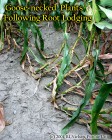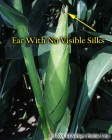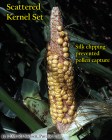
 Photo Gallery:
Photo Gallery:
Poor Kernel Set Symptoms in
Corn

These images illustrate poor kernel set symptoms in corn and were taken
on the 17th and 20th of August in a number of corn fields in westcentral
Indiana and represent a number of different hybrids from several seed
companies. Planting dates were similar among the fields (late April).
The primary cause of the poor and/or scattered kernel set appear to have
been extensive silk clipping by either corn rootworm or Japanese beetles during
pollination. The varying degrees of damage are likely related to the timing of
the silk clipping relative to the timing of pollen capture among plants. For
example, silk clipping on an ear where pollen capture by the silks and ovary
fertilization was nearly complete resulted in less barrenness than where silk
clipping occurred before significant pollen capture had occurred. One
underlying reason for such variability among plants would be uneven development
of the plants themselves. Plants that had emerged later or were otherwise
retarded in their development due to plant stresses would have silked a bit
later and been more attractive to silk clipping insects.
The secondary cause of poor kernel set in the tips of the ears where no
silk clipping had occurred was likely due to excessively warm nights during
silking and/or lack of pollen when the tip silks emerged.
NOTE: The 'thumbnail' images below are linked to
larger versions. Simply click on the image to 'pop up' a larger one in a new
browser screen. Close the 'pop up' screen to return to this page.
| Example #1 of plant to plant variability for poor kernel
set. |
Image
1:

Two
adjacent plants, the ear of one with undamaged silks, the other with silks
completely removed by insect feeding. |
 |
Image
2:

Closer view of ear with silks still attached. |
Image 3:

Closer view of ear with severe silk
clipping extending into the husk leaf tissue. Note the damaged silk ends that
would have been non-receptive to pollen germination. |
 |
Image 4:

Both ears exhibit barrenness. The barren tip of the one on
the left was caused by excessively warm nights and/or lack of pollen. The
scattered kernel set of the one on the right was caused by excessive silk
clipping by corn rootworm or Japanese beetles. |
Image 5:

The
likely insect culprit was corn rootworm. The circumstantial evidence in the
field was the presence of severely 'goose-necked' stalks resulting from root
lodging caused by extensive rootworm larvae feeding. |
|
|
| Example #2 of plant to plant variability for poor kernel
set. |
Image 1:

These ears were from a different field and different hybrid;
but illustrate the same extreme variability for kernel set observed in other
fields. As with the other fields, severe silk clipping was associated with
severe barrenness. |
|
|
| Example #3 of plant to plant variability for poor kernel
set. |
Image 1:

Another example of variability between adjacent plants for
kernel set success. |
 |
Image 2:

The less
severe barrenness was the result of pollination failure, likely due to lack of
pollen at the time the tip silks emerged. |
Image 3:

The more
severe barrenness was the result of pollination failure plus kernel
abortion. |
|
|
| Example #4 of plant to plant variability for poor kernel
set. |
Image 1:

Variability among three adjacent plants for severity of silk
clipping. |
 |
Image 2:

Closer look at variability among three adjacent plants for
severity of silk clipping. |
Image 3:

Variability among three adjacent plants for severity of
barrenness due to silk clipping. |
|
|
| Example #5 of plant to plant variability for poor kernel
set. |
Image 1:

Variability for maturity of ear, i.e., uneven plant
development within the field. |
 |
Image 2:

Variability for silk clipping and barrenness related to
maturity of ear, i.e., uneven plant development within the field. |
| Example #1 of severe barrenness associated with severe silk
clipping. |
Image
1:

Severe
silk clipping of ear that looks otherwise normal in size. |
 |
Image
2:

Closer
view of ear with severe silk clipping extending into the husk leaf tissue. Note
the damaged silk ends that would have been non-receptive to pollen
germination. |
Image
3:

Nearly
complete barrenness resulting from severe silk clipping during
pollination. |
|
|
| Example #2 of severe barrenness associated with severe silk
clipping. |
Image
1:

Severe
silk clipping of ear that looks otherwise normal in size. |
 |
Image
2:

Closer view of ear with severe silk clipping extending into
the husk leaf tissue. Note the damaged silk ends that would have been
non-receptive to pollen germination. |
Image
3:

Barren tip and
some scattered kernel set resulting from silk clipping. |
|
|
| Example #3 of severe barrenness associated with severe silk
clipping. |
Image
1:

Severe
silk clipping of ear that looks otherwise normal in size. |
 |
Image
2:

Closer view of ear with severe silk clipping extending into
the husk leaf tissue. |
Image
3:

Note
the damaged silk ends that would have been non-receptive to pollen
germination. |
 |
Image
4:

Nearly complete barrenness resulting from severe silk
clipping during pollination. |
| Example #4 of severe barrenness associated with severe silk
clipping. |
Image
1:

Severe
silk clipping of ear that looks otherwise normal in size. |
 |
Image
2:

Closer view of ear with severe silk clipping extending into
the husk leaf tissue. Note the damaged silk ends that would have been
non-receptive to pollen germination. |
Image
3:

Scattered kernel set
resulting from severe silk clipping during pollination. |
|
|
| Example silk clipping severity with later plantings of
corn. |
Image
1:

Ears from four
planting dates, ranging from 27 April to 11 June. |
 |
Image
2:

Ears from four
planting dates, with husks removed. Note the dramatic silk clipping in the ears
from the later two plantings. |
Image
3:

Ears from four
planting dates, with husks and silks removed. Note the severe barrenness in the
later two plantings caused by the extensive silk clipping. |
 |
Image
4:

17 August:
Corn rootworm beetles still feasting in silks of a later planting of
corn. |

 For other
information about corn, take a look at the Corn Growers Guidebook on the World
Wide Web at http://www.kingcorn.org
For other
information about corn, take a look at the Corn Growers Guidebook on the World
Wide Web at http://www.kingcorn.org
It is the policy of the Purdue
Agronomy Department that all persons shall have equal opportunity and
access to its programs and facilities without regard to race, color, sex,
religion, national origin, age, or disability. Purdue University is an Affirmative Action
employer. This material may be available in alternative formats.
© 2001, Purdue University
End of document
 For other
information about corn, take a look at the Corn Growers Guidebook on the World
Wide Web at http://www.kingcorn.org
For other
information about corn, take a look at the Corn Growers Guidebook on the World
Wide Web at http://www.kingcorn.org